TOYOTA 4RUNNER 1996 Owner's Guide
Manufacturer: TOYOTA, Model Year: 1996, Model line: 4RUNNER, Model: TOYOTA 4RUNNER 1996Pages: 217, PDF Size: 4.49 MB
Page 31 of 217
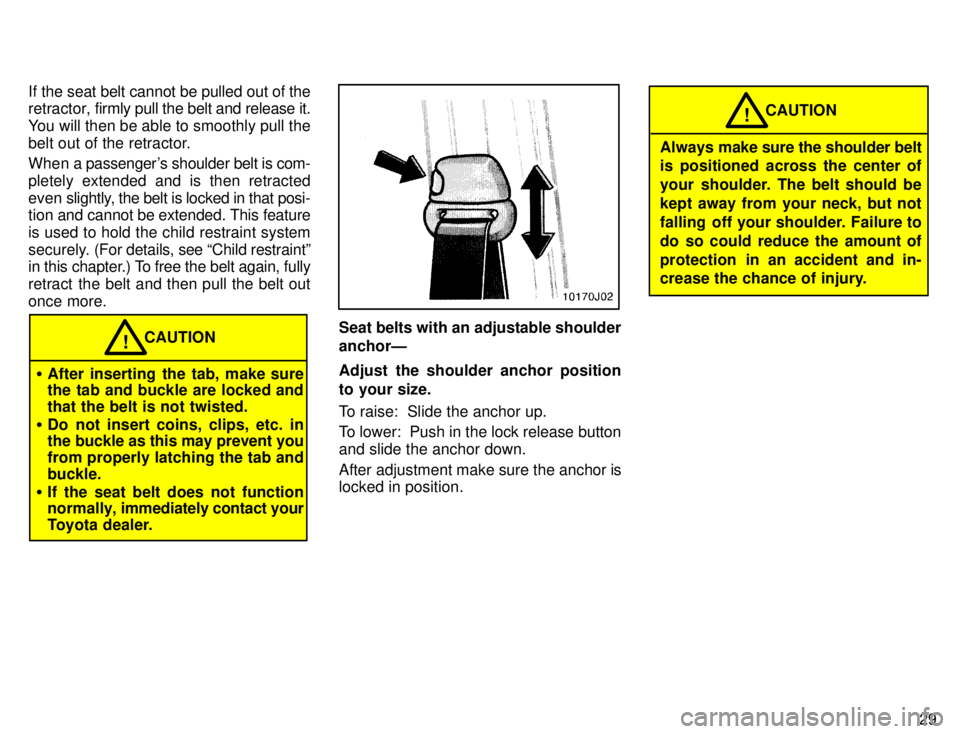
29
If the seat belt cannot be pulled out of the
retractor,
firmly pull the belt and release it.
You will then be able to smoothly pull the
belt out of the retractor.
When a passenger's shoulder belt is com-
pletely extended and is then retracted
even slightly, the belt is locked in that posi-
tion and cannot be extended. This feature
is used to hold the child restraint system
securely. (For details, see Child restraintº
in this chapter.) To free the belt again, fully
retract the belt and then pull the belt out
once more.
CAUTION!
� After inserting the tab, make sure
the tab and buckle are locked and that the belt is not twisted.
� Do not insert coins, clips, etc. in
the buckle as this may prevent you
from properly latching the tab andbuckle.
� If the seat belt does not function
normally, i mmediately contact your
Toyota dealer.
Seat belts with an adjustable shoulder anchorÐ
Adjust the shoulder anchor position
to your size.
To raise: Slide the anchor up.
To lower: Push in the lock release button
and slide the anchor down.
After adjustment make sure the anchor is
locked in position.
CAUTION!
Always make sure the shoulder belt
is positioned across the center of
your shoulder. The belt should be
kept away from your neck, but not
falling off your shoulder. Failure to
do so could reduce the amount of
protection in an accident and in-
crease the chance of injury.
Page 32 of 217
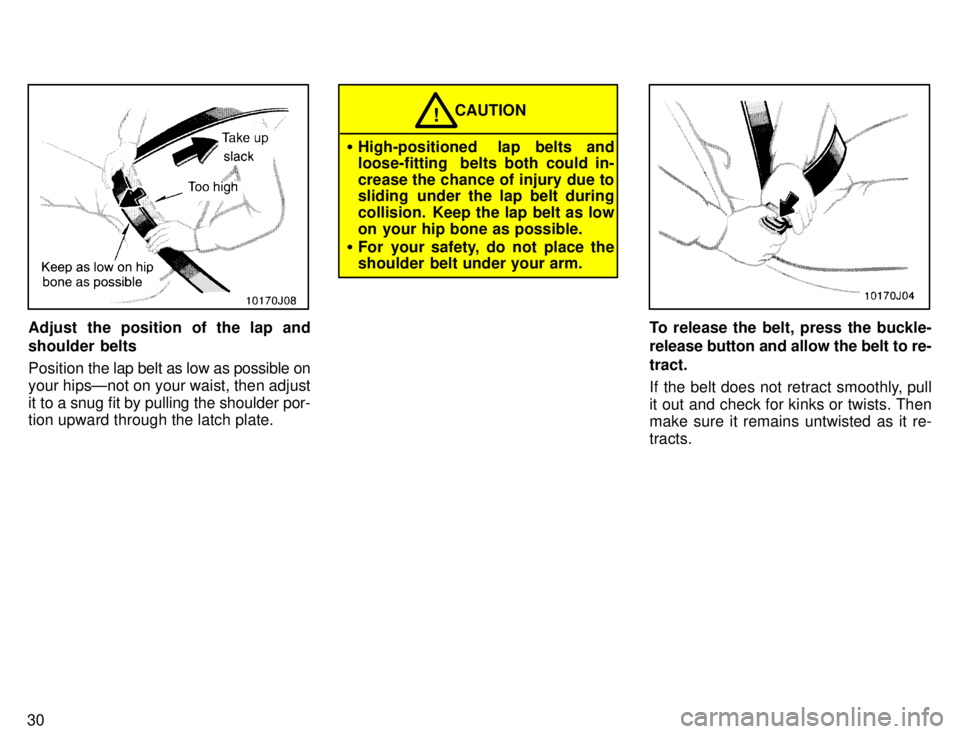
30
Adjust the position of the lap and
shoulder belts Position the lap belt as low as possible on
your hipsÐnot on your waist, then adjust
it to a snug fit by pulling the shoulder por- tion upward through the latch plate.
CAUTION!
� High-positioned lap belts and
loose-fitting belts both could in-
crease the chance of injury due to
sliding under the lap belt during
collision. Keep the lap belt as low
on your hip bone as possible.
� For your safety, do not place the
shoulder belt under your arm.
To release the belt, press the buckle-
release button and allow the belt to re- tract.
If the belt does not retract smoothly, pull
it out and check for kinks or twists. Then make sure it remains untwisted as it re- tracts.
Page 33 of 217
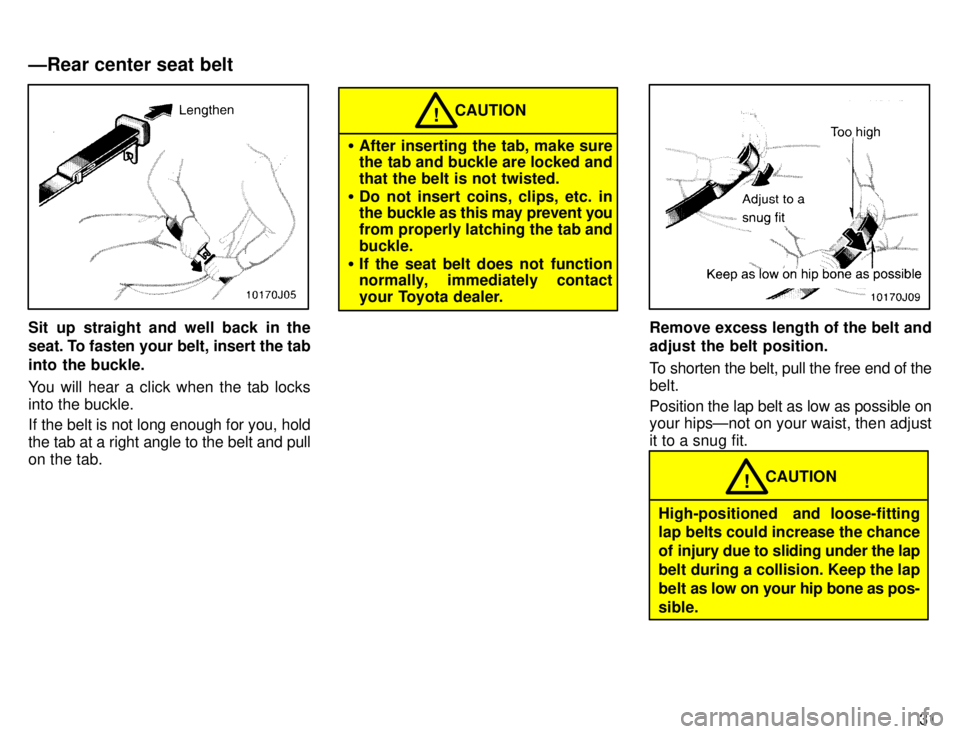
31
Sit up straight and well back in the
seat. To fasten your belt, insert the tab
into the buckle.
You will hear a click when the tab locks into the buckle.
If the belt is not long enough for you, hold the tab at a right angle to the belt and pull
on the tab.
CAUTION!
� After inserting the tab, make sure
the tab and buckle are locked and that the belt is not twisted.
� Do not insert coins, clips, etc. in
the buckle as this may prevent you
from properly latching the tab andbuckle.
� If the seat belt does not function
normally, immediately contact
your Toyota dealer.
Remove excess length of the belt and adjust the belt position.
To shorten the belt, pull the free end of the belt. Position the lap belt as low as possible on your hipsÐnot on your waist, then adjust it to a snug fit.
CAUTION!
High-positioned and loose-fitting
lap belts could increase the chance
of injury due to sliding under the lap
belt during a collision. Keep the lap
belt as low on your hip bone as pos-
sible.
ÐRear center seat belt
Page 34 of 217
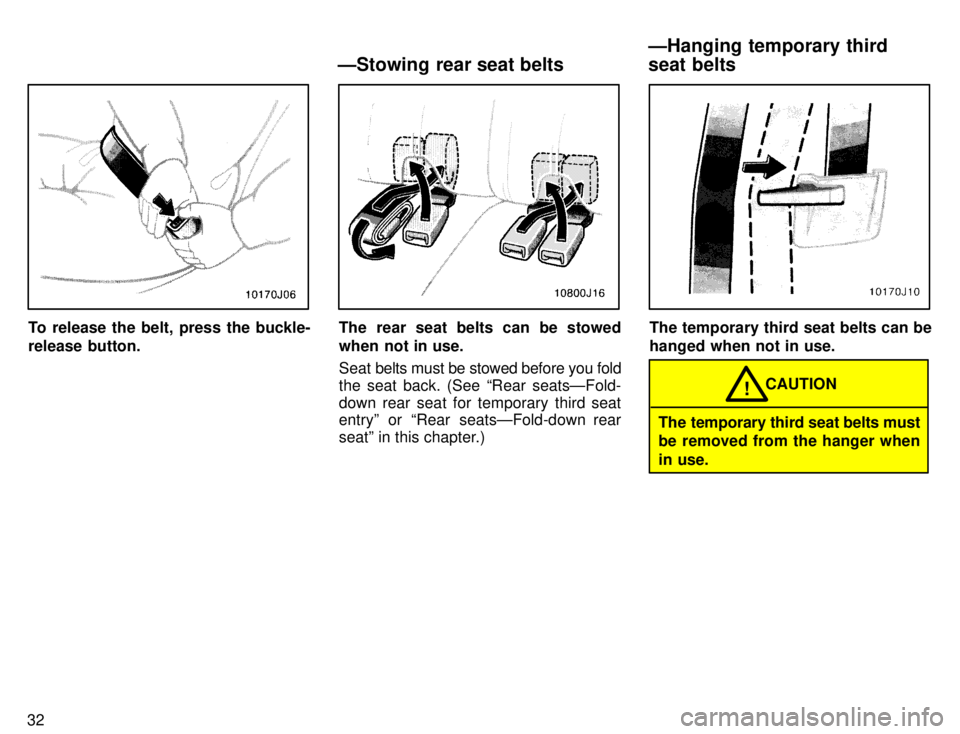
32
To release the belt, press the buckle-
release button.The rear seat belts can be stowed
when not in use.
Seat belts must be stowed before you fold
the seat back. (See Rear seatsÐFold-
down rear seat for temporary third seat
entryº or Rear seatsÐFold-down rear
seatº in this chapter.)The temporary third seat belts can be hanged when not in use.
CAUTION!
The temporary third seat belts must
be removed from the hanger when
in use.
ÐStowing rear seat belts
ÐHanging temporary thirdseat belts
Page 35 of 217

33
If your seat belt cannot be fastened se- curely because it is not long enough, a
personalized seat belt extender is avail-
able from your Toyota dealer free of charge.
Please contact your local Toyota dealer
so that the dealer can order the proper re-
quired length for the extender. Bring the heaviest
coat you expect to wear for prop-
er measurement and selection of length.
Additional ordering information is avail-
able at your Toyota dealer.
CAUTION!
When using the seat belt extender,
observe the following. Failure to
follow these instructions could re-
sult in less effectiveness of the seat
belt restraint system in case of ve-
hicle accident, increasing the
chance of personal injury. � Never use the seat belt extender if
you can fasten the seat belt with- out it.
� Remember that the extender pro-
vided for you may not be safe
when used on a different vehicle,
or for another person or at a d iffer-
ent seating position than the one
originally intended for.To connect the extender to the seat
belt, insert the tab into the seat belt
buckle so that the PRESSº signs onthe buckle-release buttons of the ex-
tender and the seat belt are both facing
outward as shown.
You will hear a click when the tab locks into the buckle.
When releasing the seatbelt, press on the
buckle-release button on the extender, not on the seat belt. This helps prevent
damage to the vehicle interior and extend-
er itself.
When not in use, remove the extender
and store in the vehicle for future use.
CAUTION!
� After inserting the tab, make sure
the tab and buckle are locked and
that the seat belt extender is not twisted.
� Do not insert coins, clips, etc. in
the buckle as this may prevent you
from properly latching the tab and buckle.
� If the seat belt does not function
normally, immediately contact your
Toyota dealer.
ÐSeat belt extender
Page 36 of 217

34
The SRS (Supplemental Restraint Sys-
tem) airbags are designed to provide
further protection to the driver and
front passenger when added to the pri-
mary protection provided by the seatbelts.
In response to a severe frontal impact, the
SRS airbags work together with the seatbelt to prevent or reduce injury by inflat- ing, in order to decrease the likelihood of
the driver's or front passenger's head or
chest directly hitting the steering wheel or dashboard. The passenger airbag is acti- vated even with no passenger in the frontseat.This indicator comes on when the
ignition key is turned to the ACCº or
ONº position. It goes off after about 6
seconds. This means the SRS airbags
are operating properly.
The SRS airbag warning light system
monitors the airbag sensor assembly, in-
flators, warning light, interconnecting wir-
ing and power sources.The SRS airbag system is designed to
activate in response to a severe frontal
impact within the shaded area be-
tween the arrows in the illustration.
The SRS airbags will deploy if the severity
of the impact is above the designed
threshold level, comparable to an approxi-
mate 20 km/h (14 mph) collision when im-
pacting straight into a fixed barrier that
does not move or deform.
If the severity of the impact is below the
above threshold level, the SRS airbags
may not deploy.
SRS airbags
Page 37 of 217

35
However, this threshold velocity will be
considerably higher if the vehicle strikes
an object, such as a parked vehicle or sign
pole, which can move or deform on im-
pact, or if it is
involved in an underride col-
lision (e.g. a collision in which the nose of
the vehicle underridesº, or goes under, the bed of a truck). It is possible with collision severity at the marginal level of airbag sensor detection
and activation that only one of your ve-
hicle's two airbags will deploy. For your safety of all occupants, be sure to always wear seat belts.
The SRS airbags are not designed to inflate if the vehicle is subjected to a
side or rear impact, if it rolls over, or if
it is involved in a low-speed frontalcollision.The SRS airbag system mainly consists
of the following components and their
locations are shown in the illustration.
1. SRS airbag warning light.
2. Steering wheel pad (airbag and inflat- or)
3. Passenger airbag module (airbag and inflator)
4. Airbag sensor assembly.
The airbag sensor assembly consists of a
safing sensor and airbag sensor.
Page 38 of 217
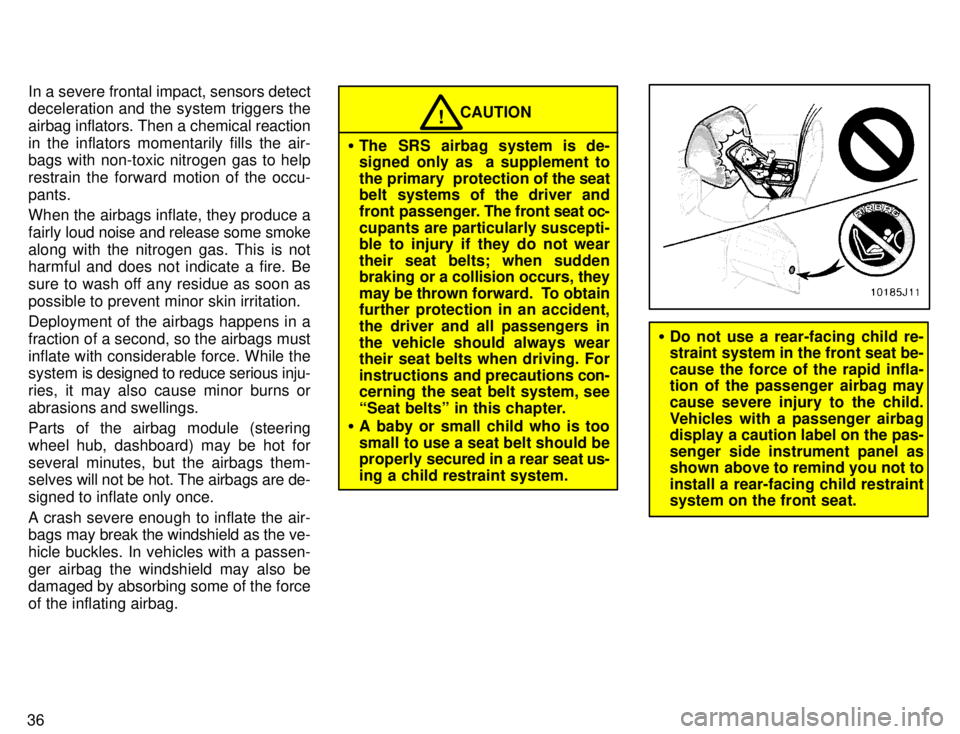
36In a severe frontal impact, sensors detect
deceleration and the system triggers the
airbag inflators. Then a chemical reaction
in the inflators momentarily fills the air-
bags with non-toxic nitrogen gas to help
restrain the forward motion of the occu-pants. When the airbags inflate, they produce a fairly
loud noise and release some smoke
along with the nitrogen gas. This is not harmful and does not indicate a fire. Be
sure to wash off any residue as soon as
possible to prevent minor skin irritation.
Deployment of the airbags happens in a
fraction of a second, so the airbags must
inflate with considerable force. While the
system is designed to reduce serious inju-
ries, it may also cause minor burns or
abrasions and swellings.
Parts of the airbag module (steering
wheel hub, dashboard) may be hot forseveral minutes, but the airbags them- selves w ill not be hot. The airbags are de-
signed to inflate only once.
A crash severe enough to inflate the air-
bags may break the windshield as the ve-
hicle buckles. In vehicles with a passen- ger airbag the windshield may also be
damaged by absorbing some of the force
of the inflating airbag.
CAUTION!
� The SRS airbag system is de-
signed only as a supplement to
the primary protection of the seat
belt systems of the driver and
front passenger. The front seat oc-
cupants are particularly suscepti-
ble to injury if they do not wear
their seat belts; when sudden
braking or a collision occurs, they
may be thrown forward. To obtain
further protection in an accident,
the driver and all passengers in
the vehicle should always wear
their seat belts when driving. For
instructions and precautions con-
cerning the seat belt system, see
Seat beltsº in this chapter.
� A baby or small child who is too
small to use a seat belt should be
properly secured in a rear seat us-
ing a child restraint system.
� Do not use a rear-facing child re-
straint system in the front seat be- cause the force of the rapid infla-
tion of the passenger airbag may cause severe injury to the child.
Vehicles with a passenger airbag
display a caution label on the pas-
senger side instrument panel as
shown above to remind you not to install a rear-facing child restraint
system on the front seat.
Page 39 of 217
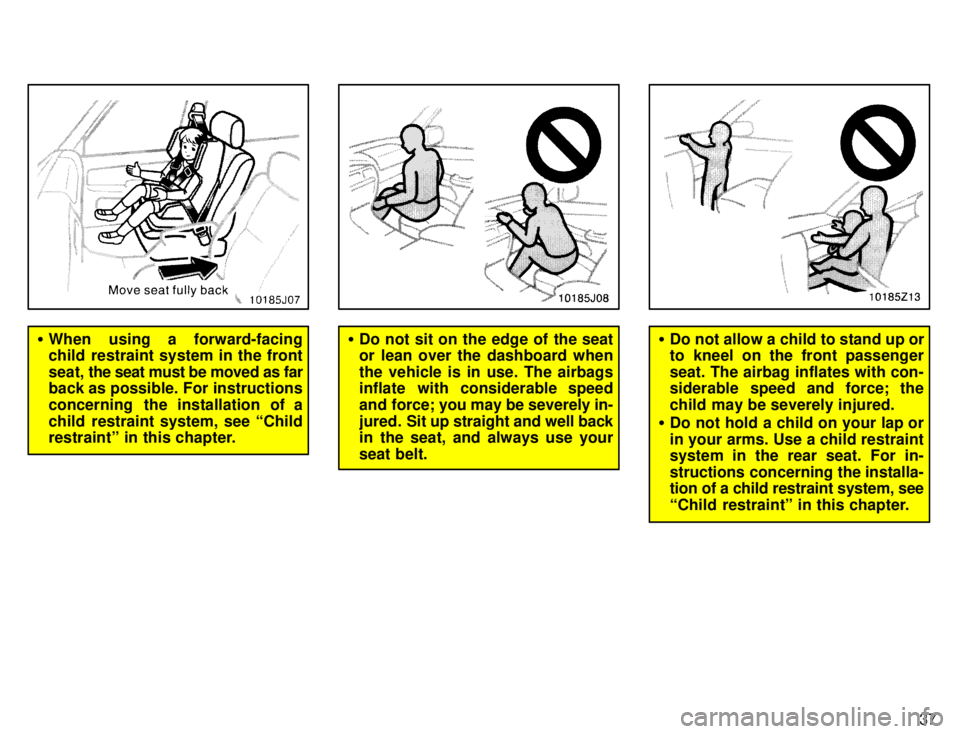
37
�When using a forward-facing
child restraint system in the front seat, the seat must be moved as far
back as possible. For instructions
concerning the installation of a
child restraint system, see Child
restraintº in this chapter.� Do not sit on the edge of the seat
or lean over the dashboard when
the vehicle is in use. The airbags
inflate with considerable speed
and force; you may be severely in-
jured. Sit up straight and well back
in the seat, and always use your
seat belt.� Do not allow a child to stand up or
to kneel on the front passenger
seat. The airbag inflates with con-
siderable speed and force; the
child may be severely injured.
� Do not hold a child on your lap orin your arms. Use a child restraint
system in the rear seat. For in-
structions concerning the installa- tion of a child restraint system, see
Child restraintº in this chapter.
Page 40 of 217
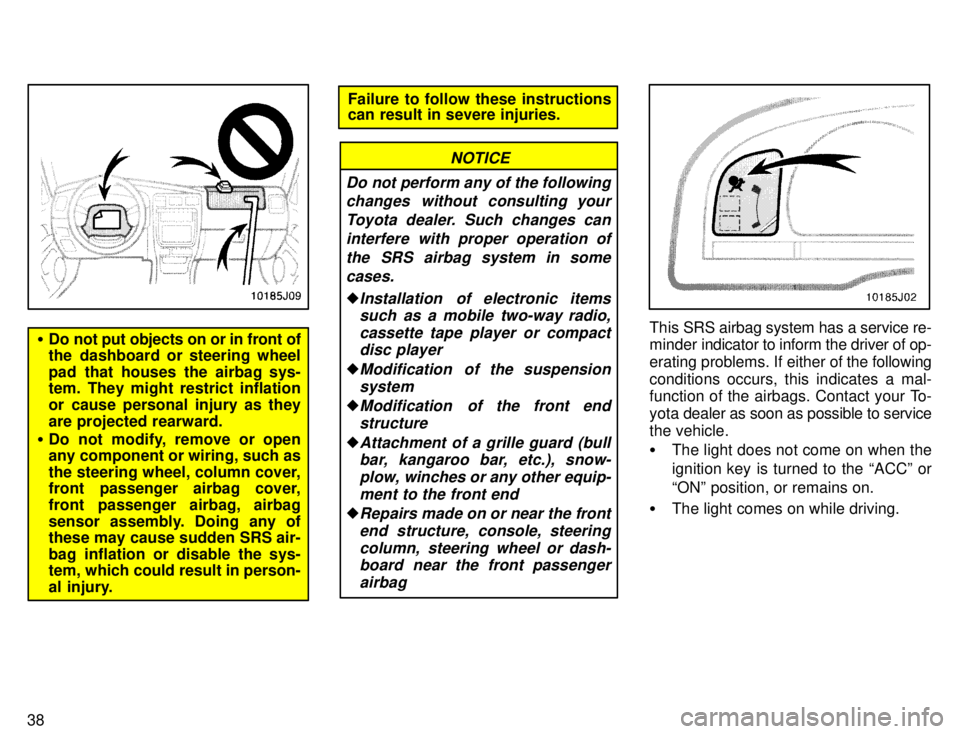
38
�Do not put objects on or in front of
the dashboard or steering wheel
pad that houses the airbag sys-
tem. They might restrict inflation
or cause personal injury as they
are projected rearward.
� Do not modify, remove or open
any component or wiring, such as
the steering wheel, column cover,
front passenger airbag cover,
front passenger airbag, airbag
sensor assembly. Doing any of
these may cause sudden SRS air-
bag inflation or disable the sys-
tem, which could result in person-
al injury.
Failure to follow these instructions can result in severe injuries.
NOTICE
Do not perform any of the following changes without consulting your
Toyota dealer. Such changes can interfere with proper operation ofthe SRS airbag system in some cases.
�Installation of electronic itemssuch as a mobile two-way radio,
cassette tape player or compactdisc player
�Modification of the suspension
system
�Modification of the front endstructure
�Attachment of a grille guard (bullbar, kangaroo bar, etc.), snow-
plow, winches or any other equip-
ment to the front end
�Repairs made on or near the front end structure, console, steeringcolumn, steering wheel or dash-board near the front passenger
airbag
This SRS airbag system has a service re-
minder indicator to inf orm the driver of op-
erating problems. If either of the following
conditions occurs, this indicates a mal-
function of the airbags. Contact your To-
yota dealer as soon as possible to service
the vehicle. � The light does not come on when the
ignition key is turned to the ACCº or
ONº position, or remains on.
� The light comes on while driving.